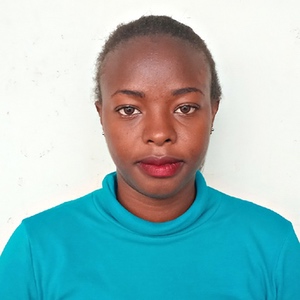March, 2020: Bugute Lutheran Primary School Project Complete!
Bugute Lutheran Primary School in Kenya now has access to a new source of safe, clean water thanks to the completion of their rain tank, which has the ability to collect 50,000 liters of water. We installed new latrines and handwashing stations for students, and we trained students and staff on improved sanitation and hygiene practices. All of these components work together to unlock the opportunity for these students to live better, healthier lives.

GIrls pose with the newly completed rain tank
"This is something. I, on behalf of the entire school, am entirely grateful for with this project. We are glad you came to our rescue. With this, I can already tell that next year we are completing our syllabus coverage in time for the national exams and we won't be worrying about water not being in the school anymore," said Head Teacher Samson Birgen.

Student poses with flowing water
Rain Tank
Construction for this 50,000-liter rain tank was successful!
Parents, staff, and students helped our artisans gather everything needed for construction. All the while, the school cooks and community members prepared meals for the artisans in addition to providing them with accommodations. Local women and men helped our artisans with their manual labor, too.

Pupils help deliver stones for rain tank construction
The process officially began with our staff and school administration looking around the school compound to try and determine the best location for a new rain tank. This needed to be the best site with good, clean roofing to catch the rainwater.
Then, we cleared the site by excavating the soil within the required measurements to make level ground for the tank foundation. The foundation was cast by laying hardcore on level ground and then reinforcing it using steel, concrete and waterproof cement.

Interior cement work
Both the drawing pipe as well as the washout pipe were affixed as the foundation was laid. The wall was built with ferro-cement techniques through 6 layers. The inner wall was plastered while rough casting was done on the outer part. Finally, the catchment area was dug, plastered, and a short staircase installed.

Attaching the dome structure and placing interior support poles
Dome construction could begin after the superstructure had been given enough time to settle. The manhole cover was fitted, inlet pipes were connected to the roof gutters, inlet screens, ventilation pipes (breathers) and overflow pipes were all done to standard.
Once finished, the rain tank was given 3 weeks to undergo complete curing before it was cleaned and handed over to Bugute Lutheran Primary School. As soon as the tank was ready for use, students and staff celebrated the presence of clean water on campus. The event was a great chance for us to acknowledge the school administration and students as the primary parties entrusted with the tools we’ve given, as well as remind them of our continued support as they develop. Happiness, thanksgiving, and appreciation were the order of the day flowing in all directions. The students and staff promised to take care of the new WaSH facilities to help them last as long as possible.

Boys pose with the rain tank
VIP Latrines
This project funded the installation of 6 new ventilated improved pit (VIP) latrines, half for girls and half for boys.

Girls in front of their new latrines
All of these new latrines have cement floors that are designed to be easy to use and clean. And with a rain tank right on school property, there should be enough water to keep them clean.

Boys in front of their new latrines
Handwashing Stations
The 2 handwashing stations were set up during training and handed over to the student health club. These were placed outside of the girls’ and boys’ latrines to encourage handwashing after latrine use. Health club members will teach other students how to properly wash their hands at the stations, make sure the stations are filled with water, and work to ensure that there is always a cleaning agent such as soap or ash available.

Students and staff with a handwashing station
New Knowledge
Hygiene and sanitation training was scheduled with the help of the school principal and the head teacher, Mr. Samson Birgen, who together ensured that the training date would be convenient for students, staff, and parent representatives. Individual teachers helped by selecting students from each class to represent the others. School staff and local church leaders attended training too.
In total, 22 people came to training. The attendance was awesome, just above the required number but not over the roof. The students had just completed their final exams of the year and they had no ongoing classes being an official holiday which made the attendance just about perfect. It was a hot mid-morning with the sun shining bright. Having no reliable tree shade within the school compound, the training was held in a classroom that was well ventilated and very conducive for learning. All the students participated quite actively in the training but a few stood out and asked questions for further clarification.

There was plenty of participation at training
We covered a number of topics including personal hygiene such as bathing, oral hygiene, and the 10 steps of handwashing; environmental hygiene; child rights; operation and maintenance of the rain tank, latrines, and handwashing stations; and leadership and governance. During the latter, the students elected their peers to lead their newly formed student health club.

Elected student health club leaders from left to right: Chair, Secretary, and Treasurer
The club will be greatly involved in the WaSH project management at school and will be responsible for encouraging good health and hygiene practices amongst their peers, teachers, and the larger community. We involved stretches, dances, and physical activities in between each topic to keep the pupils’ energy up and their minds active. By the end of the training, each pupil understood their role in sustaining clean water and good health within their school community.

A student demonstrates toothbrushing
During the discussion on menstrual management, some boys at first felt shy talking about the topic but later got more comfortable with it leaned in alongside the girls in the conversation. The teacher noted that the active gents had sisters who had just started puberty, so it was important for the boys as brothers to understand what their sisters and friends were going through and the associated risks and challenges.

Pupils learn the 10 steps of handwashing
In the leadership and governance session, the group shifted their attention to income-generating activities when the facilitator brought it up as a way the student health club might raise money for small repairs to the rain tank. The group brainstormed ideas such as growing garden vegetables and selling them to the teachers. Most of the students came from really poor backgrounds or those with small business ties, so they were very interested in learning how to earn a little income and improve their situation.

Handwashing
When an issue arises concerning the water project, the students and teachers are equipped with the necessary skills to rectify the problem and ensure the water point works appropriately. However, if the issue is beyond their capabilities, they can contact our team of field officers to assist them. In addition, we will continue to offer them unmatchable support as a part of our ongoing monitoring and maintenance program.
"We were told that you had come to conduct a water- and health-related training but from what I have gathered, you have taught us much more than just water and health. Thank you for this training," said student Steward.
Thank you for making all of this possible!


 Rainwater Catchment
Rainwater Catchment
 Rehabilitation Project
Rehabilitation Project




































